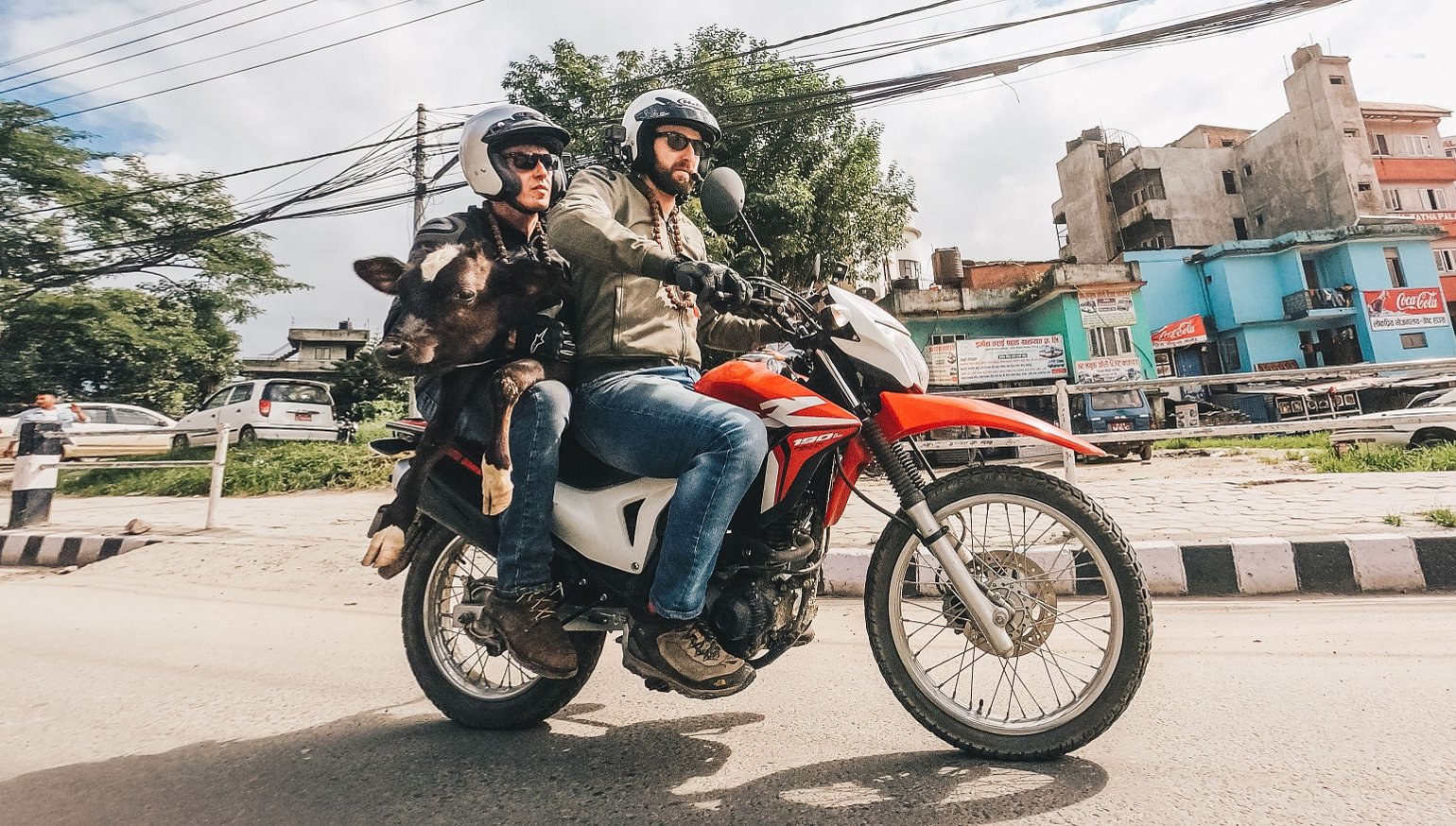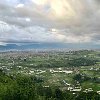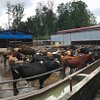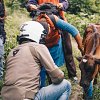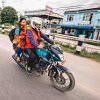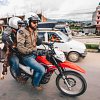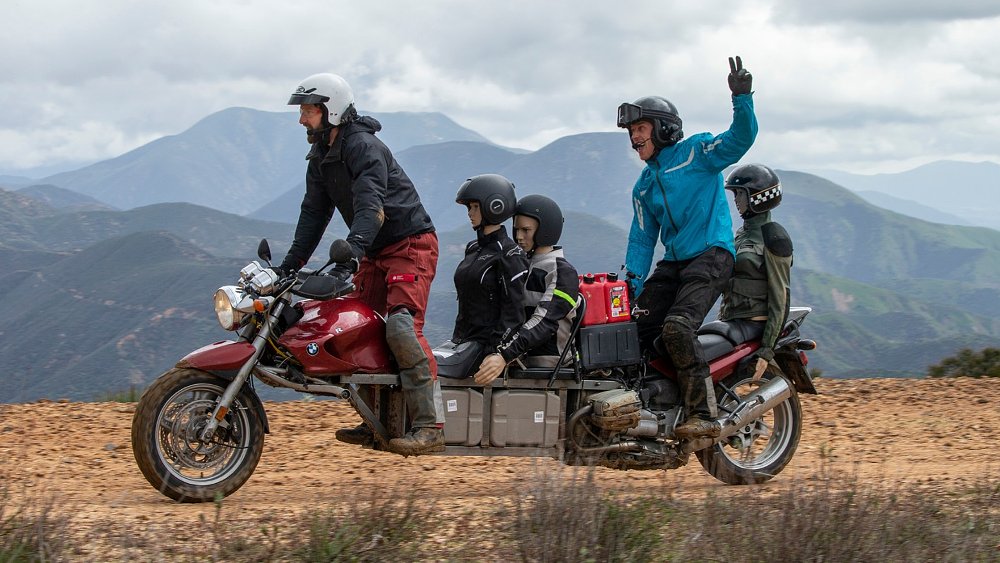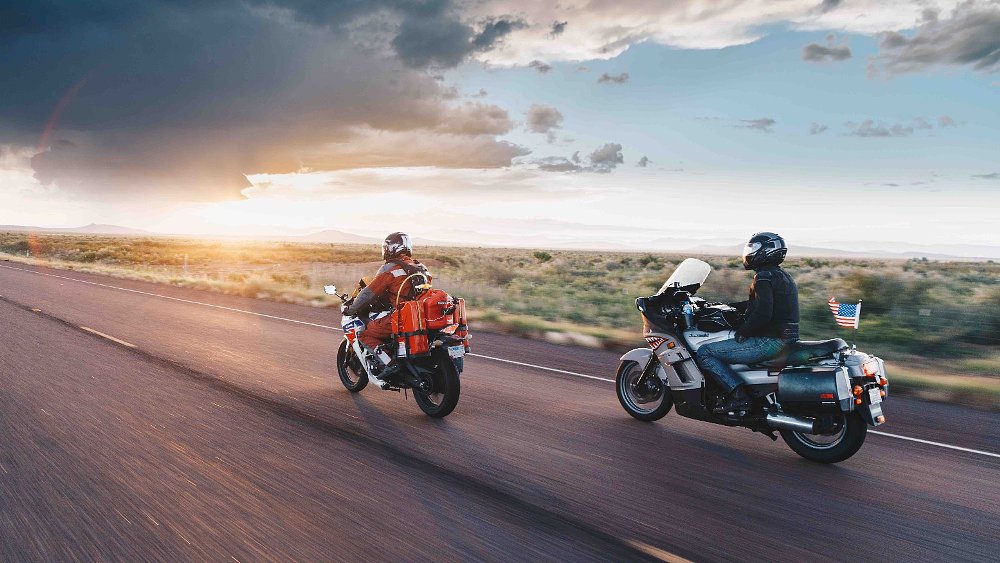A couple of years ago we spotted a short BBC video on Facebook of people in Nepal carrying a cow on a motorcycle. It might sound silly, but it was a story of perseverance — a small organization saving animals with a motorcycle, of all things, because it was the only means available.
Ram Bahadur Neupane (known as the “Bovine Biker”) became a hero of ours, and we always thought it would be excellent if we could somehow go to this little country sandwiched between India and China to see it with our own eyes. And so we made it our mission this summer: Get to Kathmandu and see if Throttle Out could make saving cows with a motorcycle a little easier.
This story is based on the latest episode of Throttle Out, now available at MotorTrend On Demand. You can find Ari and Zack on social media at @arihenning211 and @zackcourts.
To understand why Ram and his team do this work, it’s important to have some background on Nepali culture. Cows are revered in the Hindu religion, due to their association with various deities, and since four out of five people in Nepal are Hindu, the country very much leans that way. It’s illegal to kill a cow in Nepal, for example, and most people do not eat beef. (Needless to say most Nepali people probably wouldn’t appreciate that we had previously traveled around Thailand selling cheeseburgers; we kept that quiet.) The adoration of cows is also due to the animals giving milk or otherwise helping sustain a family. But, if there’s no milk, or the animal is male, they are often abandoned in the street. There are thousands of them around the city, with no home.

Ram’s facility sits on the grounds of a large Hindu temple in Kathmandu. He’s doing holy work, after all. It was hard to know what to expect, and when we arrived it was clear we had underestimated the scope of the operation. Dozens of healthy cows wandered around a paddock, while others were cordoned off to recover from various ailments. He showed us one with a broken hind leg, tied carefully so it couldn’t move, and another with a massively swollen face from being attacked by a leopard.

Then we took a look at his bike, which looks like almost every other motorcycle in Nepal; skinny tires, a long seat, and an air-cooled, single-cylinder engine. His is a Yamaha SZ R 150, but most machines are approximately this size and displacement. The occasional KTM 390 Duke or Royal Enfield Bullet look massive and luxurious. We scratched our heads at the idea of Ram and a colleague carrying cows from all over Kathmandu on this little commuter. What a way to get the job done. And pretty soon we were suiting up to head out into the city and help him rescue an abandoned cow ourselves.
Two full-sized Americans stacked up on an XR190 and bopping along the streets of Kathmandu was clearly not something people were used to seeing. We would have waved more, but staying focused is pretty key. Traffic moves like water down a hillside, as in whichever way is most open, and functions seemingly on a loose agreement not to hit each other. No cars in the oncoming lane? Well then, that’s where the massive bus is going in order to keep rolling. Our recent Thai adventure helped us adapt quickly, and we followed Ram in search of sick cows.

He spotted a couple he seemed interested in helping, but they were too big to put on the back of a bike. On and off his cell phone a few times, we gathered he was getting tips from people who had seen animals in need, and soon he pulled off near a thick stand of trees and greenery. We waded through tall weeds and eventually found a trail, on it a seemingly happy young cow munching on grass. Upon closer inspection, it had apparently been hit by a vehicle at some point. There were cuts across its whole right side, and most worryingly, a horribly swollen and infected wound on its right hind leg. It was too unwell to drape over a bike, unfortunately, and when Ram requested to use our camera truck we obliged, loading the injured subject with the help of a dozen or so onlookers.
After finding another wayward calf, we watched with amazement as people helped slide the animal onto the lap of Ram’s petite colleague. In no time they were ready to go, and it was time for the two Throttle Out gibronis to lend a hand. Cozied up next to a parked car next to a four-lane thoroughfare, we found a cow that Ram deemed the next inductee into his bovine rehab facility. Passersby were less enthusiastic to help two foreigners put a cow on a bike, but eventually people helped and next thing Ari knew he had a cow slung across his lap. My job was to pilot the bike as gently as possible, without losing sight of Ram in traffic and getting lost in Kathmandu.

Riding with a cow slung across the passenger's lap is quite a challenge. Our vehicle as a whole was wider, for starters, and there was quite a bit less room on the seat for people. It got really exciting when the cow became uncomfortable and started to wiggle and reorient itself. Throwing its significant weight around is daunting, but also the head and hind end can slap the back of the pilot’s elbows, which (with any luck) are holding the handlebar. The last thing we wanted to do was crash ourselves into the ground while carrying a sacred animal through the capital city. We learned as we went, and made it back to Ram’s workplace with our payload intact. A few cows saved, and an experience under our belts that would be key to assessing how we could help the Ram’s mission.

Getting some Royal help saving holy cattle
Leading up to this trip, we had reached out to Royal Enfield, the famous India-based brand, to see if it had any interest in helping the Bovine Biker do his work. Yes, was the answer, to the tune of a free motorcycle, donated in full to the cow rescue mission. It was generous, and probably especially good news for Ram since we wouldn’t be attempting to modify his bike. The next day, we took delivery of the Royal Enfield Classic 350 at a local metal-working shop in Kathmandu, where we would dive into our project. Taking a tour of the shop that we would be using to prepare our cow-carrying contraption was pretty eye-opening in itself.

Right away it was clear that Nepal’s version of OSHA is a little less stringent than in some other countries. We saw what might be the world’s oldest operational welder, a massive drill press that was out of balance, and angle grinders with no switches. The metal chop saw had no trigger and, maybe more concerning, no plug on the power cord — just stick the bare wires into the outlet and hope it makes contact, we were told. But, even if it wasn’t what we were used to, there was a welder, chop saw, grinders, a drill press, and lots of metal we were allowed to use. It wasn’t fancy, but the layers of grime and wear on everything suggested this was a shop that had cranked out a lot of projects over the years.

First the big question: how to carry a cow with a Royal Enfield. After considering a Free Willy-style sling hanging off the back, as well as a sort of dual-sidecar concept (which we might revisit, by the way), we settled on a basic utility trailer. We figured that way even if Ram hated our idea he’d still have a free motorcycle to use. With that we turned to the rack of Throttle Out’s signature building material: steel square tube. Soon we were confident we had what we needed for a simple frame with railings, but wheels and an axle were nowhere to be seen. A shopping trip was in order.
We asked where we might find a junkyard and were told at first that there was no such place. Perhaps our team of locals was nervous that it would portray Nepal in a bad light if we saw Kathmandu’s underbelly, but they need not have worried. If Star Wars taught us anything it’s that no matter how technologically advanced a place gets, there will always be “junk.” And some of it will be marvelous. (I’m looking at you, Millennium Falcon.) Eventually we found our way to a nondescript neighborhood where we were led into a weathered and gloriously dense junkyard. A pile of bumpers the size of a large SUV, rows of brake rotors stacked on metal shelves, and countless used cylinder heads from who-knows-what diesel engines, all seeping gently into the earth floor. Plus, axles galore.

An interesting thing we learned about looking for parts in Kathmandu is that specialty shops are king. We needed wheels to fit the hubs, tires to fit the wheels, and the tires mounted — and we went to a different shop for each of those tasks. To be fair, it was all in the same neighborhood, and in about an hour we were back at the shop, measuring exactly how much width we would be allowed with our tiny axle of unknown origins.

When it came to welding, it wasn’t the motor-driven, gas-shielded, point-and-shoot MIG setup that Ari’s used to in the TO Garage, but rather a dilapidated stick welder. No moving parts, no canister of CO2. Just slap a rod in the stick holder, tap it against the metal to strike an arc, and then let the electricity and molten metal glue together your workpiece.

Ari was determined to teach himself the technique, and spent much of the 20 hours of travel to Asia studying a guide to basic welding. It paid off. The basic frame took shape, and fit onto the axle, and we were ready to start building railings. However, as the first of two days in the shop wound down, we realized there was just no way all of the work was going to get done at the rate we were going. The shop’s proprietor was a ninja with the stick welder and offered to tackle the trailer pieces we’d cut while the two of us built a custom hitch for the Enfield. Aside from the crew of the shop practically refusing to use any safety gear (gloves, welding mask, or shoes), this was a big relief.

Creating a tow hitch from scratch isn’t terribly complicated, frankly, but creating one that didn’t fold under the weight of a trailered cow was more intimidating. We cut tabs out of plate steel and drilled them so that the bolts for the upper shock and passenger footpeg mounts would thread through. Then we welded to those plates to sections of steel rod, which reached back past the back of the rear fender. The rear end of the rods connected to a stubby section of square tube running horizontally, like a bumper. One side of the hitch was welded to our little bumper, and then we jumped on it. No discernible flex, and the Enfield’s suspension still worked perfectly. We called it a success and painted it.

With the (mostly) Nepali-built trailer hooked to our new machine, we had one serious task before we gifted it to the Bovine Biker: a stress test. We would be embarrassed if it broke, but we’d be mortified if it came apart while Ram was riding it. After finding a steep, windy dirt road in the foothills outside the city we slammed the bike and trailer over gnarly terrain and through mud puddles all afternoon. I rode in the trailer (along with 220 pounds of concrete) to simulate a cow, and everything held together. A bovine miracle.

The only negative was that we learned that the Classic 350’s gearing is quite tall, and towing uphill with more than 400 pounds in the trailer wasn’t realistic. We agreed we would have to warn Ram about climbing hills, as we didn’t have time to source different final-drive gearing. (Much to our surprise, Enfield uses a one-piece, captured sprocket/hub piece that makes changing gearing pretty tricky.)
Also, fenders would have been a good idea on the trailer. There was no real danger of a cow getting tangled in the wheel, but all the chocolate milk we rode through was splattered everywhere. After spraying off the bike and making a couple of last-minute tweaks to the hitch for stability, we delivered the rig to Ram and his team. He clearly appreciated Royal Enfield’s generosity, and was willing to give the trailer a try, so we followed him back out into the city for its true maiden voyage.
To our surprise, Ram was a natural with the trailer, trundling safely and confidently through traffic and even cracking off a few U-turns as easy as you like. As we sidled up to a slightly lame and unsuspecting cow, our nerves were tingling. Please, oh please, let it work. We helped Ram shove the reluctant passenger aboard, closed the trailer gate, and watched him set off.
Happily, the mission was a success. The cow sprayed an impressive load of manure all over the waterproof-plywood deck of the trailer, which made it slippery. And kinda gross. But, feces fountain aside, it was satisfying to watch Ram carry a larger cow than he would have been able to previously, without help, across the city to safety.

It was a proud moment for us, using Throttle Out to help someone with more passion than resources. More than that, it was inspiring to see how average humans can make a difference when they really believe in something. From the workers at the metal shop to random pedestrians in the city, people regularly pitch in to help Ram do his work — not because they have extra time or money, but because they feel it is right. Honestly, we hope Ram can someday afford a truck. But until then, we’re proud that motorcycles are associated with his mission.
Ram’s cow rescue mission operates largely on donations. If you would like to contribute to his facility and his team, you can find information on mailing lists and donations here. We have heard through our contacts there that Ram is still using the trailer, and has rescued about 15 more animals with it since we left.




